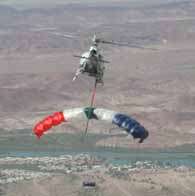Piece of the Sun returns to Earth

In a dramatic ending that marks a beginning in scientific research, NASA's Genesis spacecraft is set to swing by Earth and jettison a sample return capsule filled with particles of the Sun that may ultimately tell us more about the genesis of our solar system. "The Genesis mission -- to capture a piece of the Sun and return it to Earth -- is truly in the NASA spirit: a bold, inspiring mission that makes a fundamental contribution to scientific knowledge," said Steven Brody, NASA's program executive for the Genesis mission, NASA Headquarters, Washington.
On September 8, 2004, the drama will unfold over the skies of central Utah when the spacecraft's sample return capsule will be snagged in midair by helicopter. The rendezvous will occur at the Air Force's Utah Test and Training Range, southwest of Salt Lake City.
"What a prize Genesis will be," said Genesis Principal Investigator Dr. Don Burnett of the California Institute of Technology, Pasadena, Calif. "Our spacecraft has logged almost 27 months far beyond the moon's orbit, collecting atoms from the Sun. With it, we should be able to say what the Sun is composed of, at a level of precision for planetary science purposes that has never been seen before."
The prizes Burnett and company are waiting for are hexagonal wafers of pure silicon, gold, sapphire, diamond and other materials that have served as a celestial prison for their samples of solar wind particles. These wafers have weathered 26-plus months in deep space and are now safely stowed in the return capsule. If the capsule were to descend all the way to the ground, some might fracture or break away from their mountings; hence, the midair retrieval by helicopter, with crew members including some who have performed helicopter stunt work for Hollywood.
"These guys fly in some of Hollywood's biggest movies," said Don Sweetnam, Genesis project manager at NASA's Jet Propulsion Laboratory in Pasadena, Calif. "But this time, the Genesis capsule will be the star."
The Genesis capsule -- carrying the agency's first sample return since the final Apollo lunar mission in 1972, and the first material collected beyond the Moon -- will enter Earth's atmosphere at 9:55 am Mountain Time. Two minutes and seven seconds after atmospheric entry, while still flying supersonically, the capsule will deploy a drogue parachute at 33 kilometers (108,000 feet) altitude. Six minutes after that, the main parachute, a parafoil, will deploy 6.1 kilometers (20,000 feet) up. Waiting below will be two helicopters and their flight crews looking for their chance to grab a piece of the Sun.
"Each helicopter will carry a crew of three," said Roy Haggard, chief executive officer of Vertigo Inc. and director of flight operations for the lead helicopter. "The lead helicopter will deploy an eighteen-and-a-half foot long pole with what you could best describe as an oversized, Space-Age fishing hook on its end. When we make the approach we want the helicopter skids to be about eight feet above the top of the parafoil. If for some reason the capture is not successful, the second helicopter is 1,000 feet behind us and setting up for its approach. We estimate we will have five opportunities to achieve capture."
The helicopter that does achieve capture will carry the sample canister to a clean room at the Michael Army Air Field at the U.S. Army Dugway Proving Ground, where scientists await their cosmic prize. The samples will then be moved to a special laboratory at NASA's Johnson Space Center, Houston, where they will be preserved and studied by scientists for many years to come.
"I understand much of the interest is in how we retrieve Genesis," added Burnett. "But to me the excitement really begins when scientists from around the world get hold of those samples for their research. That will be something."
Mission Overview
Genesis' main goal is to probe the mystery of oxygen in the solar system. The amounts of oxygen isotopes vary among the solar system bodies, though the reason for the variety is totally unknown. Different parts of the solar system have distinct proportions of three isotopes of oxygen called O16, O17 and O18. O16 is the most common form of an oxygen atom, containing eight protons and eight neutrons to add up to an atomic weight of about 16. O17 has one extra neutron, whereas O18 has two extra neutrons.
Past Missions to Collect Solar Wind
Apollo 11, 12, 14, 15 and 16 (NASA): The solar wind composition experiment on these missions that took astronauts to the Moon between 1969 and 1972 was a 1.4- by 0.3- meter (55- by 11-inch) aluminum foil sheet on a pole. This sheet was exposed to the Sun for periods ranging from 77 minutes on Apollo 11 to a period of 45 hours on Apollo 16. On Apollo 16, a platinum sheet was also used. Solar wind particles embedded themselves in the foil, which was returned to Earth for laboratory analysis. The chemical composition of the embedded solar wind included isotopes of the light noble gases helium-3, helium-4, neon-20, neon-21, neon-22 and argon-36. The Apollo foils showed that the ratio of neon-20 to neon-22 in the solar wind was almost 40 percent higher than what is found in Earth's atmosphere. Such a large difference was totally unanticipated. Many scientists believe that this difference was caused by an early major loss of Earth's atmosphere. Comparison of Genesis data with the terrestrial atmosphere for nitrogen and the other noble gases (argon, krypton and xenon) may well provide a definitive test of that theory.
More information is available at www.nasa.gov/genesis
















